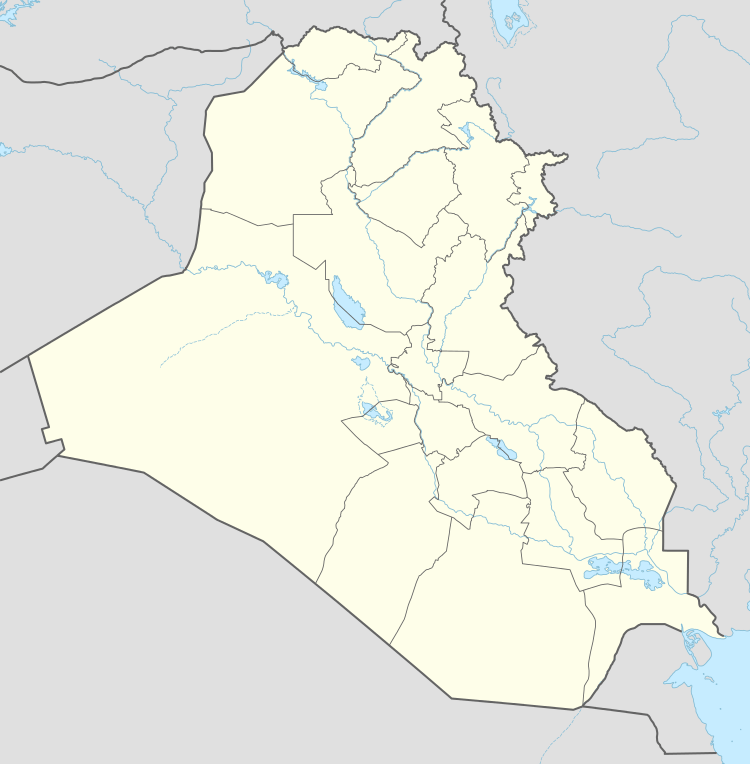Kani Masi
Kani Masi (Kurdish: کانی ماسی, romanized: Kanî Masî,[1] Arabic: كاني ماسي),[nb 1][4][5] also known as Ain Nuni (Arabic: عينا دنونى, Syriac: ܥܝܢܢܘ̈ܢܐ),[nb 2][1] is a village and sub-district in Dohuk Governorate in Kurdistan Region, Iraq. It is located in the district of Amadiya and the historical region of Barwari. The village is mostly inhabited by Assyrians.[9]
Kani Masi | |
|---|---|
 Kani Masi Location in Iraq | |
| Coordinates: 37°13′40″N 43°26′14″E | |
| Country | |
| Region | |
| Governorate | Dohuk Governorate |
| District | Amadiya District |
| Sub-district | Kani Masi |
In the village, there are churches of Mar Sawa and Mart Shmuni.[7]
Etymology
The Syriac and Kurdish names of the village, Ain Nuni and Kani Masi, respectively, both translate to "spring of fish".[7] Ain Nuni is derived from "ain" ("spring" in Syriac) and "nuni" ("fish" in Syriac),[10][11] whilst Kani Masi is a combination of "kani" ("spring" in Kurdish) and "masi" ("fish" in Kurdish).[12][13]
History
Clay vessels dated to between 1415 and 1290 B.C were discovered during an archaeological survey in the area of Ain Nuni.[14] The church of Mar Sawa was constructed in the 10th century, and underwent restorations in 1742.[7] In 1850, 20 Nestorian families inhabited Ain Nuni, and were served by one functioning church and one priest as part of the diocese of Berwari.[8] Prior to the First World War, Ain Nuni was inhabited by approximately 350 Assyrians.[7] The village was ransacked by Ottoman Turkish and Kurdish forces in the spring of 1915, amidst the Assyrian genocide,[15] but the villagers survived by fleeing under the leadership of Agha Petros to the vicinity of Urmia in Iran.[6] In the winter of 1915-1916, whilst in Iran, 120 villagers died, c. 20 were killed, and 10 women were abducted.[7] The villagers eventually returned after seven years.[6]
A school was constructed in 1928, and the village became the centre of a sub-district in 1934.[7] 70 families populated Ain Nuni in 1938.[7] Ain Nuni was inhabited by 420 Assyrians in 1957.[2] At the onset of the First Iraqi–Kurdish War in 1961, Kurdish rebels led by Mustafa Barzani attacked the village and killed a bishop, two priests, and over 15 men.[16] Assyrians from nearby villages repelled the Kurds,[7] and the surviving villagers took refuge in larger towns, and returned at the war's end in 1970.[17][6] KDP forces seized Ain Nuni from Iraqi National Defence Battalions in September 1987 during the Iran-Iraq War and occupied it for six days.[18][19] On 27 February 1988, the village was destroyed and its population of 180 Assyrian families was forcibly evacuated by the Iraqi government during the Al-Anfal campaign.[7] 20 families returned after the establishment of the Iraqi no-fly zones in the aftermath of the 1991 uprisings in Iraq.[17][6] The Turkish Armed Forces established a military base close to Ain Nuni in 1996 as part of the Kurdish-Turkish conflict.[9]
The Supreme Committee of Christian Affairs constructed 58 houses, a church, and hall, and provided two electrical generators by 2011.[2] Ain Nuni was struck by Turkish airstrikes on 5 September 2018.[20] Kurdistan Workers' Party (PKK) militants clashed with the Turkish army near Ain Nuni on 12 December 2018.[21]
Gallery
 "Assyrian Village Kani Masi Demolished by Saddam's Soldiers". Assyrian Guardian. May 1992.
"Assyrian Village Kani Masi Demolished by Saddam's Soldiers". Assyrian Guardian. May 1992. "Assyrian Village Kani Masi Demolished by Saddam's Soldiers". Assyrian Guardian. May 1992.
"Assyrian Village Kani Masi Demolished by Saddam's Soldiers". Assyrian Guardian. May 1992.
References
Notes
Citations
- "كانــي ماســي". Ishtar TV (in Arabic). Retrieved 27 April 2020.
- "Kanimase (Aina D None)". Ishtar TV. 9 July 2011. Retrieved 27 April 2020.
- "Mar Sawa church – Kane Masa". Ishtar TV. 6 October 2011. Retrieved 27 April 2020.
- "Tirkiyê çend deverên çiyayî yên Kanî Masî topbaran kir". Rudaw Media Network (in Kurdish). 15 April 2019. Retrieved 19 December 2019.
- "پێشمەرگەکانی پارتی(پەدەکە) گردی کانی ماسی-یان ڕادەستی سوپای تورک کرد". Firat News Agency (in Kurdish). Retrieved 19 December 2019.
- Eshoo (2004), p. 2.
- Donabed (2015), pp. 310-311.
- Wilmshurst (2000), p. 150.
- Gish (2013), pp. 185-186.
- Awde, Lamassu & Al-Jeloo (2007), p. 41.
- Awde, Lamassu & Al-Jeloo (2007), p. 75.
- Joseph (1972), p. 85.
- Brauer (1993), p. 101.
- "2,500-year-old beer jars found in northern Iraq". Daily Sabah. 26 August 2018. Retrieved 27 April 2020.
- Yacoub (2016), p. 124.
- Donabed (2015), p. 144.
- Khan (2008), p. 2.
- "Genocide in Iraq: The Anfal Campaign Against the Kurds". Human Rights Watch. July 1993. p. 75. Retrieved 27 April 2020.
- Malovany (2017), p. 357.
- "Turkish Airstrikes Threaten Assyrian Villages in Northern Iraq". Assyrian Policy Institute. 6 September 2018. Retrieved 27 April 2020.
- "VIDEO: Turkish army, PKK battle near northern border of Kurdistan Region". Kurdistan 24. 13 December 2018. Retrieved 27 April 2020.
Bibliography
- Awde, Nicholas; Lamassu, Nineb; Al-Jeloo, Nicholas (2007). Aramaic (Assyrian/Syriac) Dictionary & Phrasebook. Hippocrene Books.
- Brauer, Erich (1993). The Jews of Kurdistan. Wayne State University Press.
- Donabed, Sargon George (2015). Reforging a Forgotten History: Iraq and the Assyrians in the Twentieth Century. Edinburgh University Press.
- Eshoo, Majed (2004). The Fate Of Assyrian Villages Annexed To Today's Dohuk Governorate In Iraq And The Conditions In These Villages Following The Establishment Of The Iraqi State In 1921 (PDF). Translated by Mary Challita.CS1 maint: ref=harv (link)
- Gish, Peggy Faw (2013). Walking Through Fire: Iraqis' Struggle for Justice and Reconciliation. Wipf and Stock Publishers.
- Joseph, Isya (1972). Devil Worship: The Sacred Books and Traditions of the Yezidiz. Gorham Press.
- Khan, Geoffrey (2008). The Neo-Aramaic Dialect of Barwar. Brill.
- Malovany, Pesach (2017). Wars of Modern Babylon: A History of the Iraqi Army from 1921 to 2003. University Press of Kentucky.
- Wilmshurst, David (2000). The Ecclesiastical Organisation of the Church of the East, 1318–1913. Peeters Publishers.
- Yacoub, Joseph (2016). Year of the Sword: The Assyrian Christian Genocide, A History. Translated by James Ferguson. Oxford University Press.